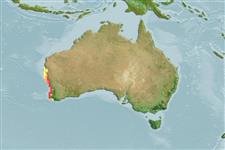Elasmobranchii (haaien en roggen) (sharks and rays) >
Orectolobiformes (Carpet sharks) >
Orectolobidae (Carpet or nurse sharks)
Etymology: Orectolobus: orektos (Gr.), stretched out; lobus (L.), from lobos (Gr.), rounded projection or protuberance, referring to long nasal barbels of Squalus barbatus (=O. maculatus). (See ETYFish); floridus: Latin for full of flowers (i.e., florid), referring to “rich, floral pattern” of bands and blotches on dorsal surface. (See ETYFish).
More on authors: Last & Chidlow.
Environment: milieu / climate zone / depth range / distribution range
Ecologie
marien; diepte 42 - 85 m (Ref. 74934). Tropical
Eastern Indian Ocean: southwestern Australia.
Grootte / Gewicht / Leeftijd
Maturity: Lm ? range ? - ? cm
Max length : 75.0 cm TL mannelijk / geslacht onbekend; (Ref. 74934); 71.4 cm TL (female)
Korte beschrijving
Morfologie | Morfometrie
This species is characterized by the following: dorsal coloration when fresh strongly ornamented, mottled yellowish brown; side of the head with black spots; nasal barbel with 2 simple lobes; postspiracular lobes are poorly developed, distance across preorbital group 1.2-1.4 times interspace between preorbital group and postspiracular lobe (PO/PO-PS1), 12-14 times base length of anterior postspiracular lobe (PO/PS1); base of anterior postspiracular lobe 9-12 in its distance from postorbital group (PO- PS1/PS1), 5-6 in its distance from posterior postspiracular lobe (PS1-PS2/PS1); above eye is a weak tubercle; back without wart-like tubercles; dorsal fins low, raked, not upright; first dorsal-fin origin over mid pelvic-fin base; interdorsal space 0.3-0.4 times the anal-fin base length; anal-fin inner margin 1.1-1.2 times the anal-fin posterior margin; 18-20 teeth in upper jaw, medial row at symphysis of upper jaw absent; 47-52 monospondylous centra; 145-150 total vertebral centra (Ref. 74934).
Collected from the inner continental shelf off southwestern Australia (Ref. 74934).
Levenscyclus en paargedrag
Maturiteit | Voortplanting | Paaien | Eieren | Fecunditeit | Larven
Last, P.R. and J.A. Chidlow, 2008. Two new wobbegong sharks, Orectolobus floridus sp. nov. and O. parvimaculatus sp. nov. (Orectolobiformes: Orectolobidae), from southwestern Australia. Zootaxa 1673:49-67. (Ref. 74934)
Status op de Rode Lijst van het IUCN (Ref. 130435)
Gevaar voor de mens
Harmless
Gebruik door de mens
Meer informatie
Lokale namenSynoniemenMetabolismePredatorenEcotoxicologieVoortplantingMaturiteitPaaienPaaiaggregatiesFecunditeitEierenOntwikkeling van de eieren
Leeftijd/GrootteGroeiLengte-gewichtLengte-lengteLengtefrequentiesMorfometrieMorfologieLarvenLarvale populatiedynamiekRekruteringAbundantieBRUVS
ReferentiesAquacultuurAquacultuurprofielKweeklijnenGeneticaElectrophoresesErfelijkheidZiektesVerwerkingNutrientsMassaconversie
Tools
Speciale rapporten
Download XML
Internetbronnen
Estimates based on models
Preferred temperature (Ref.
123201): 16 - 22.5, mean 17.9 °C (based on 15 cells).
Fylogenetische diversiteitsindex (Ref.
82804): PD
50 = 0.5012 [Uniqueness, from 0.5 = low to 2.0 = high].
Bayesian length-weight: a=0.00389 (0.00180 - 0.00842), b=3.12 (2.94 - 3.30), in cm total length, based on all LWR estimates for this body shape (Ref.
93245).
Trofisch niveau (Ref.
69278): 3.8 ±0.6 se; based on size and trophs of closest relatives
Fishing Vulnerability (Ref.
59153): Moderate to high vulnerability (50 of 100).
